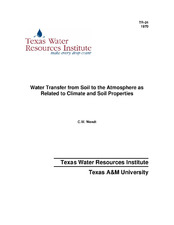| dc.description.abstract | Facilities and Systems - Design of the lysimetric facility of the project began in 1966. During 1967, soil cores were taken for the lysimeters, and in 1968 an unforseen temperature problem in the lysimeters was solved. A total of 9 undisturbed soil cores were made into lysimeters. Since cores were procured, the lysimeters have the "natural" soil properties. Such lysimeters will be valuable tools for further studies. The lysimeters were designed for either visual or recorded readout of data.
Initially, plans were made to use a datalogger owned by the USWB to collect the data. However, it is not reliable, and a system of strip chart recorders had to be procured to record the data. This proved to be time consuming, and subjected the data to possible human error when it was reduced to numerical form from the strip charts. Research-Results - Either the combination method of van Bavel or the Bowen Ratio will provide a fair estimate of evaporation from a wet soil surface in the area. In general, the combination method tends to overestimate while the Bowen Ratio tends to underestimate evaporation. This is due to the fact that the combination method places a strong emphasis on this parameter. Average wind speeds in the area commonly exceed 4 m/sec. Conductivity Studies - The conductivity of the Olton loam soil is very low at fairly low soil water pressures corresponding to high contents. This is an asset in preventing evaporation losses, but may be detrimental to crop production in that the crops need to develop extensive root systems to use the stored soil moisture. Canopy Effects on Evaporation - Evaporation within a cotton crop canopy following rains is related to the net radiation reaching the soil surface. After the surface dries, the moisture content of the soil surface is the limiting parameter. Effects of Crude Oil on Evaporation - Crude oil applied to the wet soil surfaces of the lysimeters following rains suppressed evaporation immediately following the rains. However, the value of the crude oil in preserving soil moisture over long periods needs further investigation. Diurnal Changes in Soil Moisture - Soil water content in the upper 30 cm (12 inches) of the soil apparently changes diurnally with major diurnal changes in soil temperature. Such changes may cause stress in young crop seedlings. | en |


